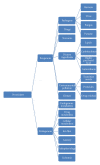Oxidative stress, prooxidants, and antioxidants: the interplay
- PMID: 24587990
- PMCID: PMC3920909
- DOI: 10.1155/2014/761264
Oxidative stress, prooxidants, and antioxidants: the interplay
Abstract
Oxidative stress is a normal phenomenon in the body. Under normal conditions, the physiologically important intracellular levels of reactive oxygen species (ROS) are maintained at low levels by various enzyme systems participating in the in vivo redox homeostasis. Therefore, oxidative stress can also be viewed as an imbalance between the prooxidants and antioxidants in the body. For the last two decades, oxidative stress has been one of the most burning topics among the biological researchers all over the world. Several reasons can be assigned to justify its importance: knowledge about reactive oxygen and nitrogen species production and metabolism; identification of biomarkers for oxidative damage; evidence relating manifestation of chronic and some acute health problems to oxidative stress; identification of various dietary antioxidants present in plant foods as bioactive molecules; and so on. This review discusses the importance of oxidative stress in the body growth and development as well as proteomic and genomic evidences of its relationship with disease development, incidence of malignancies and autoimmune disorders, increased susceptibility to bacterial, viral, and parasitic diseases, and an interplay with prooxidants and antioxidants for maintaining a sound health, which would be helpful in enhancing the knowledge of any biochemist, pathophysiologist, or medical personnel regarding this important issue.
Figures
References
-
- Kumar A, Rahal A, Diwedi SK, Gupta MK. Bacterial prevalence and antibiotic resistance profile from bovine mastitis in Mathura, India. Egyptian Journal of Dairy Sciences. 2010;38(1):31–34.
-
- Kumar A, Rahal A, Verma AK. In-Vitro antibacterial activity of hot aqueous extract (HAE) of Ocimum sanctum (Tulsi) leaves. Indian Journal of Veterinary Medicine. 2011;36(2):75–76.
-
- McGinnis JM, Foege WH. Actual causes of death in the United States. Journal of the American Medical Association. 1993;270(18):2207–2212. - PubMed
-
- Mahima, Rahal A, Deb R, et al. Immunomodulatory and therapeutic potentials of herbal, traditional/indeginous and ethnoveterinary medicines. Pakistan Journal of Biological Sciences. 2012;15(16):754–774. - PubMed
-
- Ahmad AH, Rahal A, Tripathi A. Optimising drug potential of plants. Proceedings of the 6th Annual Conference of the Recent Trends in Development of Herbal Drugs: Challenges and Opportunities (ISVPT '06); 2006; Bihar, India. pp. 23–25.
Publication types
MeSH terms
Substances
LinkOut - more resources
Full Text Sources
Other Literature Sources
Medical



